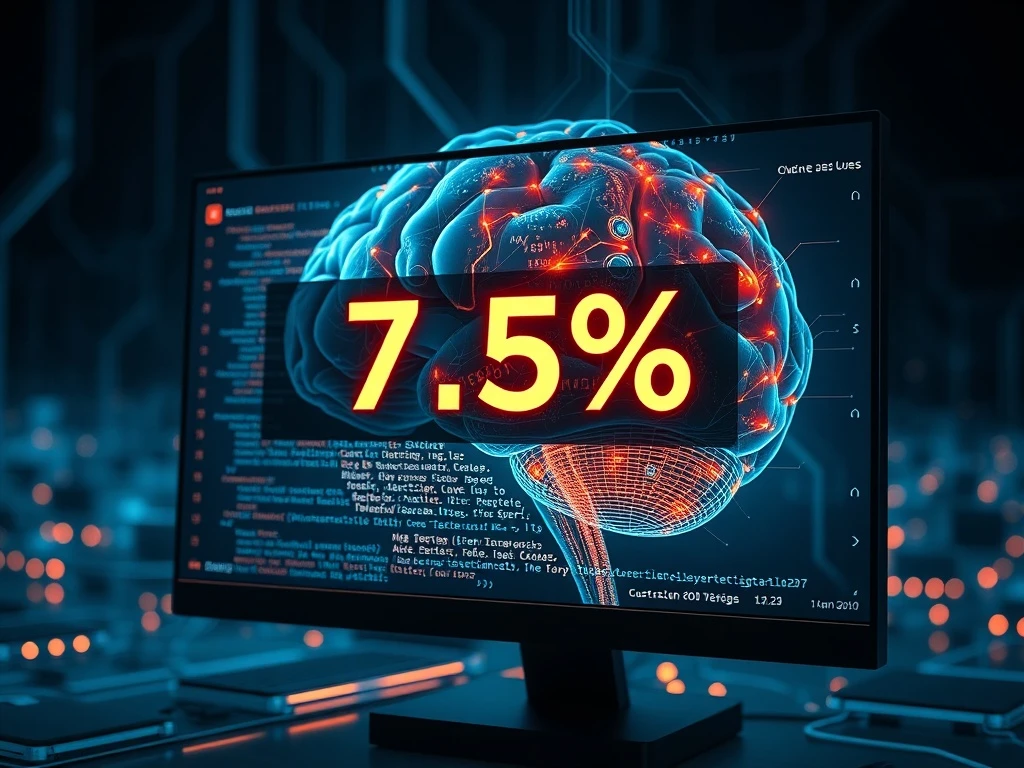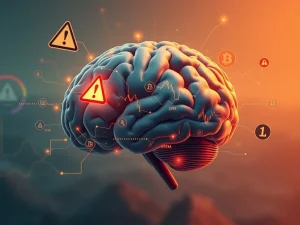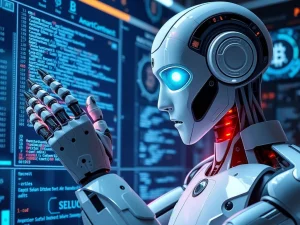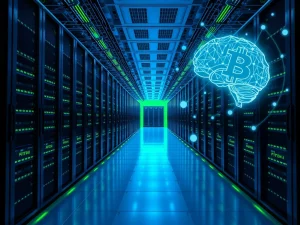AI Coding Challenge: Shocking 7.5% Score Exposes Critical Limitations

In the rapidly evolving world of technology, the promise of Artificial Intelligence often feels boundless. From self-driving cars to sophisticated medical diagnostics, AI’s potential seems to touch every industry. But what happens when that promise meets a brutal reality check? The inaugural K Prize AI Coding Challenge has just delivered precisely that, sending ripples of concern through the tech world, especially for those deeply invested in the precision-critical realm of cryptocurrencies and blockchain. A top score of a mere 7.5% in a rigorous, real-world coding competition isn’t just a low number; it’s a stark reminder that while AI’s capabilities are growing, its practical readiness for high-stakes software engineering tasks, particularly in areas like smart contract development, is still a significant hurdle.
Unpacking the K Prize AI Coding Challenge: A New Benchmark for AI Readiness
Launched by the esteemed Laude Institute and co-founded by Perplexity’s Andy Konwinski, the K Prize AI Coding Challenge was designed with a singular, ambitious goal: to genuinely test AI’s ability to solve real-world software engineering problems. Unlike many traditional AI benchmarks, this competition wasn’t about static datasets that models might have inadvertently “seen” during training. Instead, it pioneered a “contamination-free” methodology.
- Dynamic Problem Sourcing: The K Prize uses GitHub issues that are flagged *after* submission deadlines, ensuring that AI models cannot leverage pre-existing knowledge or train against the test data. This dynamic approach aims to provide a more accurate assessment of an AI’s true generalization capabilities.
- Focus on Open-Source: The competition deliberately favors open-source models and imposes limits on computational resources. This promotes accessibility, allowing smaller teams and independent researchers to participate and contribute, democratizing AI innovation.
- Rigorous Realism: Andy Konwinski, a key architect, emphasized the challenge’s difficulty, stating, “We’re glad we built a benchmark that is actually hard.” This focus on genuine problem-solving sets it apart from more theoretical evaluations.
The results, however, were undeniably sobering. The highest score achieved was a mere 7.5%, awarded to Brazilian prompt engineer Eduardo Rocha de Andrade. This figure stands in stark contrast to other benchmarks like SWE-Bench, which reported top scores of 75% on its “Verified” test and 34% on the more challenging “Full” test. This significant discrepancy immediately raises questions about the true state of AI readiness in practical coding scenarios.
Why AI Readiness is Still a Concern: Hype vs. Reality
The vast difference between the K Prize’s 7.5% and SWE-Bench’s higher scores isn’t just a statistical anomaly; it points to a critical issue: benchmark contamination. Many AI models, particularly large language models, are trained on vast swathes of internet data. If test problems exist within this training data, models might appear to perform well not because they understand and solve the problem, but because they’ve effectively memorized or overfit to it. Princeton researcher Sayash Kapoor highlighted this, noting that without experiments like the K Prize, it’s hard to distinguish between low scores due to inherent difficulty and those due to contaminated data.
Konwinski himself has been vocal about the pervasive “hype” surrounding AI’s current capabilities. He critically remarked, “If you listen to the hype, it’s like we should be seeing AI doctors and AI lawyers and AI software engineers, and that’s just not true.” The K Prize results serve as a powerful reality check, demonstrating that while AI can be an incredible assistant, it is far from being an autonomous, highly capable software engineer.
This reality has profound implications. For industries where precision, security, and error-free execution are paramount—like finance, healthcare, and critically, the cryptocurrency space—understanding the true limitations of software engineering AI is non-negotiable. Relying on AI for tasks it’s not yet ready for could lead to catastrophic consequences.
Blockchain AI: Navigating High-Stakes Development with Caution
For the cryptocurrency sector, the findings of the K Prize are particularly pertinent. Imagine the complexities of developing smart contracts, where a single line of faulty code can lead to millions in lost funds or critical security vulnerabilities. Or consider the intricacies of automated audits, algorithmic trading strategies, or even AI-driven decentralized applications (dApps). These areas demand an unparalleled level of coding precision and reliability.
While blockchain AI tools can certainly offer assistance—perhaps by generating boilerplate code, identifying potential vulnerabilities, or suggesting optimizations—the K Prize’s results unequivocally suggest that AI is not yet capable of autonomous, high-stakes decision-making or error-free code generation in these environments. The “contamination-free” nature of the K Prize benchmark reveals that AI’s generalization capabilities, crucial for handling novel and complex blockchain-specific challenges, are still nascent.
This means human oversight remains not just important, but absolutely critical. Developers working on blockchain projects should view AI as a powerful co-pilot, not an auto-pilot. Leveraging AI for tasks where it excels—like pattern recognition or data analysis—while retaining human expertise for complex problem-solving, security audits, and final code verification, is the pragmatic path forward. Errors in blockchain are often irreversible, making this cautionary approach essential.
The Future of Software Engineering AI: An Iterative Path to Mastery
Despite the initial sobering results, the K Prize isn’t about discouraging AI development; it’s about refining it. Konwinski’s visionary pledge of $1 million for the first open-source model to achieve over 90% accuracy in the K Prize underscores a broader commitment to democratizing AI innovation and pushing the boundaries of what’s possible. This incentive, coupled with the competition’s open-source and resource-efficient model, aims to challenge the industry to move beyond proprietary systems dominated by large tech firms.
The K Prize’s iterative design, which plans to update test problems every few months, is a testament to its long-term vision. This continuously evolving challenge demands true adaptability from AI models, fostering breakthroughs in generalization and real-world applicability. Konwinski anticipates that as the K Prize evolves, participants will adapt, leading to “genuine mastery of complex tasks.”
This initiative represents a pivotal step in redefining how AI is evaluated. By prioritizing transparency, accessibility, and real-world relevance over theoretical benchmarks, the K Prize is pushing the industry to focus on practical, deployable solutions. It’s a call to action for developers, researchers, and tech enthusiasts to contribute to building more robust and reliable AI systems.
Conclusion: A Sobering Yet Hopeful Outlook for AI in Crypto
The inaugural K Prize AI Coding Challenge has provided a much-needed dose of reality, highlighting the significant gap between AI’s perceived potential and its current practical readiness, especially for critical applications like blockchain development. The 7.5% top score is a clear indicator that while AI tools can augment human capabilities, they are not yet ready for autonomous, high-stakes software engineering tasks. This isn’t a setback for AI, but rather a crucial calibration. It underscores the importance of rigorous, real-world benchmarks and the continued need for human expertise and oversight in complex technological domains. As the K Prize evolves, it promises to be a catalyst for genuine advancements, guiding AI towards true mastery and ensuring its responsible integration into our increasingly digital world.
Frequently Asked Questions (FAQs)
Q1: What is the K Prize AI Coding Challenge?
A1: The K Prize is a rigorous AI coding competition launched by the Laude Institute and Perplexity co-founder Andy Konwinski. It’s designed to test AI’s real-world problem-solving skills in software engineering by using dynamically sourced, “contamination-free” GitHub issues, ensuring models can’t rely on pre-existing knowledge of test data.
Q2: Why was the 7.5% top score concerning?
A2: The 7.5% top score is concerning because it reveals significant limitations in current AI programming capabilities for real-world tasks. It stands in stark contrast to other benchmarks (like SWE-Bench’s 75%), suggesting that many AI models may struggle with generalization and are not yet practically ready for complex, high-stakes software development without extensive human oversight.
Q3: How does the K Prize differ from other AI benchmarks like SWE-Bench?
A3: The K Prize distinguishes itself by using a “contamination-free” methodology. Unlike SWE-Bench, which uses static problem sets that AI models might inadvertently train against, the K Prize dynamically sources GitHub issues flagged *after* submission deadlines. This prevents models from leveraging pre-existing knowledge, providing a more accurate assessment of true generalization capabilities.
Q4: What are the implications of the K Prize results for blockchain development?
A4: For blockchain, the implications are significant. AI-driven tools for smart contract development, automated audits, or algorithmic trading require robust coding capabilities and precision. The K Prize’s findings suggest that while AI can assist in these areas, it is not yet capable of autonomous, high-stakes decision-making, emphasizing that human oversight remains critical to ensure reliability and security in blockchain applications.
Q5: What is the long-term vision of the K Prize?
A5: The K Prize’s long-term vision is to iteratively refine AI’s problem-solving abilities through a continuously evolving challenge. Andy Konwinski has pledged $1 million for the first open-source model to achieve over 90% accuracy, aiming to democratize AI innovation and push models towards “genuine mastery of complex tasks” in real-world applications.









